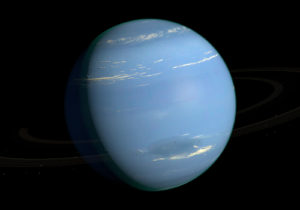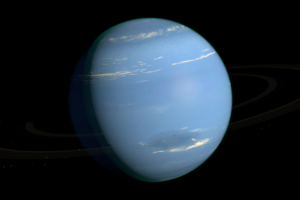How To See Saturn With A Telescope – An Observing Guide
Ask amateur telescope users what’s the most beautiful thing in the sky, and lots of them will say Saturn. In fact many say their first sight of it was what turned them on to astronomy.
Saturn looks starlike to the eye alone, but it shines steadily, as planets tend to do, and it has a distinct golden color. So Saturn is a lovely object to view with the eye alone. Binoculars will enhance its color, and even small telescopes will show you Saturn’s rings.
Key Takeaways:
- Saturn can be seen in a small amateur telescope, starting from a 3-inch refractor model and above.
- Saturn is not always visible to everyone on Earth, because sometimes it lies too close to the Sun from our vantage point on Earth to view at night.
- To find the current location of Saturn, We suggest using an astronomy app such as Gas Giants or Star Walk 2 on your mobile phone with a Stellarium planetarium simulator.
Galileo Galilei was the first person to ever observe Saturn through an antique telescope in 1610 and now, a few hundred years later, it is quite easy to look at the same planet with a much better instrument that he had at the time.
Saturn through a telescope is something everyone should see at least once. You do not need to own an expensive or very powerful refracting / reflecting telescope to observe it satisfyingly. Of all the planets that can be observed, Saturn is the best one to see in a small telescope because it is always quite bright and it looks great even with a modest magnification power.
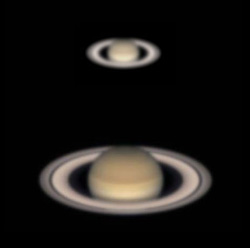
Image credit: NASA/Hubble Space Telescope.
The planet can be seen in a small amateur telescope, starting from a 3-inch refractor model and above.
But don’t expect Hubble-like performance from viewing Saturn with your backyard telescope. The image pair above depicts how the ringed planet might look through a small (4″) telescope on a mediocre night (top) and through a larger (8″), better telescope on a night when the air is especially still (bottom).
How to Find Saturn in the Night Sky
The position of the planet Saturn in the night sky changes over time. It is orbiting the Sun just as Earth is, except that it takes Saturn 29-years (Earth years, of course), to complete its orbital period around the Sun.
The position of Saturn in your night sky will also depend on your location on Earth. Saturn is not always visible to everyone on Earth, because sometimes it lies too close to the Sun from our vantage point on Earth to view at night.
Jupiter and Saturn are near one another on the sky’s dome, with Saturn following Jupiter westward across the sky from mid-to-late evening till dawn. Look first for brilliant Jupiter and you’ll find Saturn a short hop to the east of the king planet. Remember, east is in the direction of sunrise.
When Is Saturn Visible In 2020?
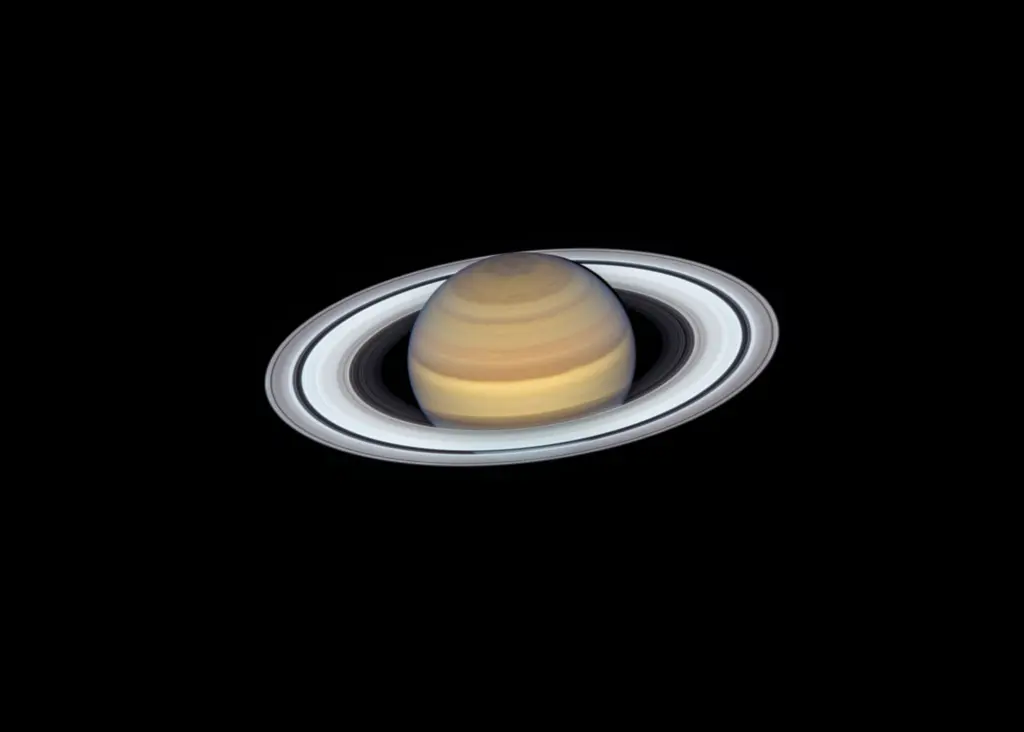
Credits: NASA, ESA, A. Simon (GSFC), M.H. Wong (University of California, Berkeley) and the OPAL Team
Saturn is really far from the Sun and takes about 29.5 years to complete one full orbit around it. This means that from our point of view, we can find Saturn positioned in the same constellation for 2.5 years until it moves on to the next constellation.
Its famous rings are only visible in a telescope. They were at their maximum tilt toward Earth in October 2017 and are now closing to our line of sight. Saturn will begin 2020 in the constellation Sagittarius the Archer, but in late March it will move into the boundaries of Capricornus the Sea Goat.
Thanks to retrograde motion, however, it will turn back to the west and re-enter Sagittarius at the beginning of July. It will return to Capricornus by mid-December. Saturn will be primarily visible in the morning before dawn from Jan. 29 to July 19. It will be visible in the evening sky from July 20 to Dec. 31.
How To Find Saturn On Your Phone
To find the current location of Saturn, We suggest using an astronomy app such as Gas Giants or Star Walk 2 on your mobile phone with a Stellarium planetarium simulator. This will show you exactly where to look for Saturn from your location.
These apps can show you what’s in the sky and their exact position in real-time. Use the search function and enter the celestial object you wish to find, it will point you in the right direction. It’s easy and will save you some time. Once you know what you are looking out, point your telescope towards it and enjoy the view.
Related
How To See Saturn’s Rings With A Telescope
Saturn is best-known for its glorious ring system. While all the large planets have rings, Saturn’s are chiefly composed of water-ice fragments in sizes ranging from fine particles to house-size chunks. These reflect sunlight efficiently and make the rings shine brightly.
Amazingly, the rings are only about 66 feet (20 meters) thick, but they span a distance that’s 4,100 to 75,000 miles (6,598 to 120,700 kilometers) from the planet — an area that’s so large, that a number of small moons orbit within them, carving out gaps in the rings.
The rings of Saturn should be visible in even the smallest telescope at 25x (magnified by 25 times). A good 3-inch scope at 50x (magnified by 50 times) can show them as a separate structure detached on all sides from the ball of the planet.
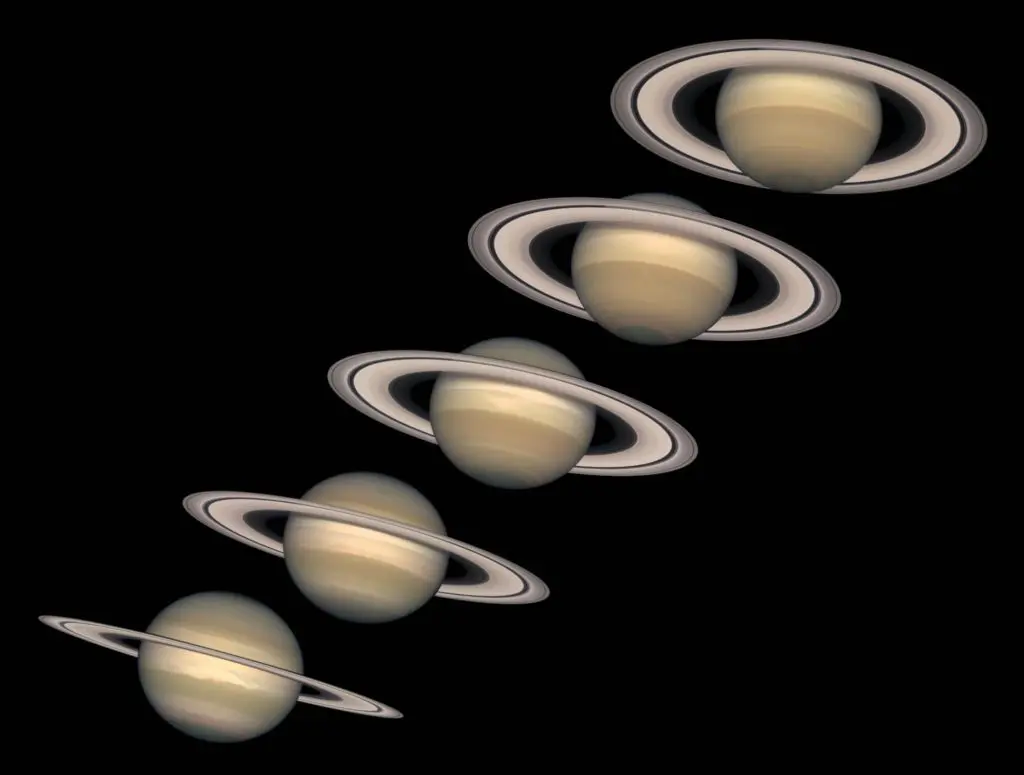
Credit: NASA and The Hubble Heritage Team (STScI/AURA)
There are the rings, of course, with their complex structure and segmentation. You’ll easily see the two main A and B rings, and in steady skies at 100x or more, you may see the large gap between the two main rings. This is the Cassini division.
More than most planets, Saturn displays a striking 3-D effect caused by the darkened edges of the disk and, when you can see them before and after opposition, the shadows cast by the rings on the planet.
The apparent tilt of the rings this year is about 24 degree, nearly as large as it gets, and you may be able to trace the outer rings all the way around the planet, even the far side.
How To See Saturn’s Moons With A Telescope
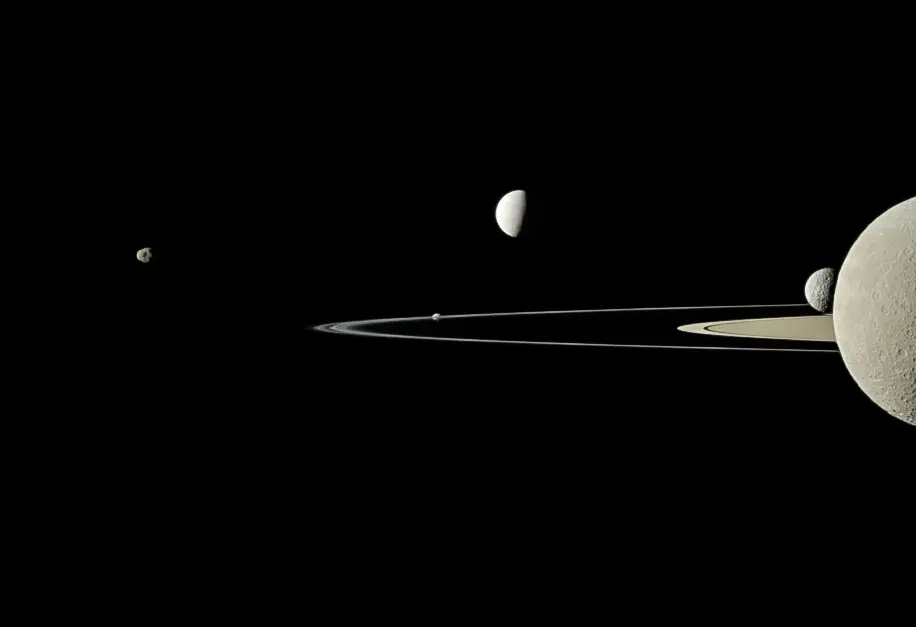
Saturn has over 80 known moons, and 53 of them are officially named. Its biggest moon, Titan, is larger than the planet Mercury (but much lighter, due to its high ice content). Saturn also hosts six more good-size moons and dozens of house-size moonlets.
You can easily see Titan through a backyard telescope, plus three or four of the next largest, depending on the telescope’s aperture.
Even though Titan is far away, it’s large size means it’s a fairly bright and easy telescope target. A 6-inch or larger telescope may show the color of the dense yellow-orange clouds on this large 8th-magnitude moon,
This orange-brown target shines with a magnitude between 8.2 and 9.0 and orbits Saturn every 15 days.
To identify the moons using a sky-charting app like SkySafari 5, Star Walk or Stellarium Mobile, center Saturn and zoom in until you see the moons displayed. If the app time is set to Now, it will match what you see in your telescope, except for any image inverting or mirroring your telescope’s optics might introduce.
The Saturn Moons and Gas Giants apps for iOS are designed to provide realistic views of the planet and moons at any time you choose. They incorporate buttons to flip the view to match your telescope’s optics.
Saturn’s moons are worlds unto themselves — massive enough to have geologic activity, interesting terrain, subsurface liquid saltwater oceans and even atmospheres.
Conclusion
You can easily see Saturn with a backyard beginner telescope, granted that it is in your field of vision high above the horizon and that you are not located in an area with a high level of light pollution.
The planet is famous for how easy it is to observe with any kind of telescope. Refractor or Reflector, small or large aperture will influence the quality of the image but ultimately, any kind of telescope will allow you to see Saturn.
ABOUT US
We are a team of active amateur astronomers, here to help you with all your astronomy and science related needs – this is anything, from reviewing the latest telescopes to be released to talking about gravity and neurons. The Big Bang Optics was started because of our love for astronomy and to help others like us find the best telescope and accessories.
LEGAL DISCLAIMER
The Big Bang Optics is a participant in the Amazon Services LLC Associates Program, an affiliate advertising program designed to provide a means for sites to earn advertising fees by advertising and linking to Amazon.com. The Big Bang Optics also participates in affiliate programs with Clickbank and other sites. The Big Bang Optics is compensated for referring traffic and business to these companies.


